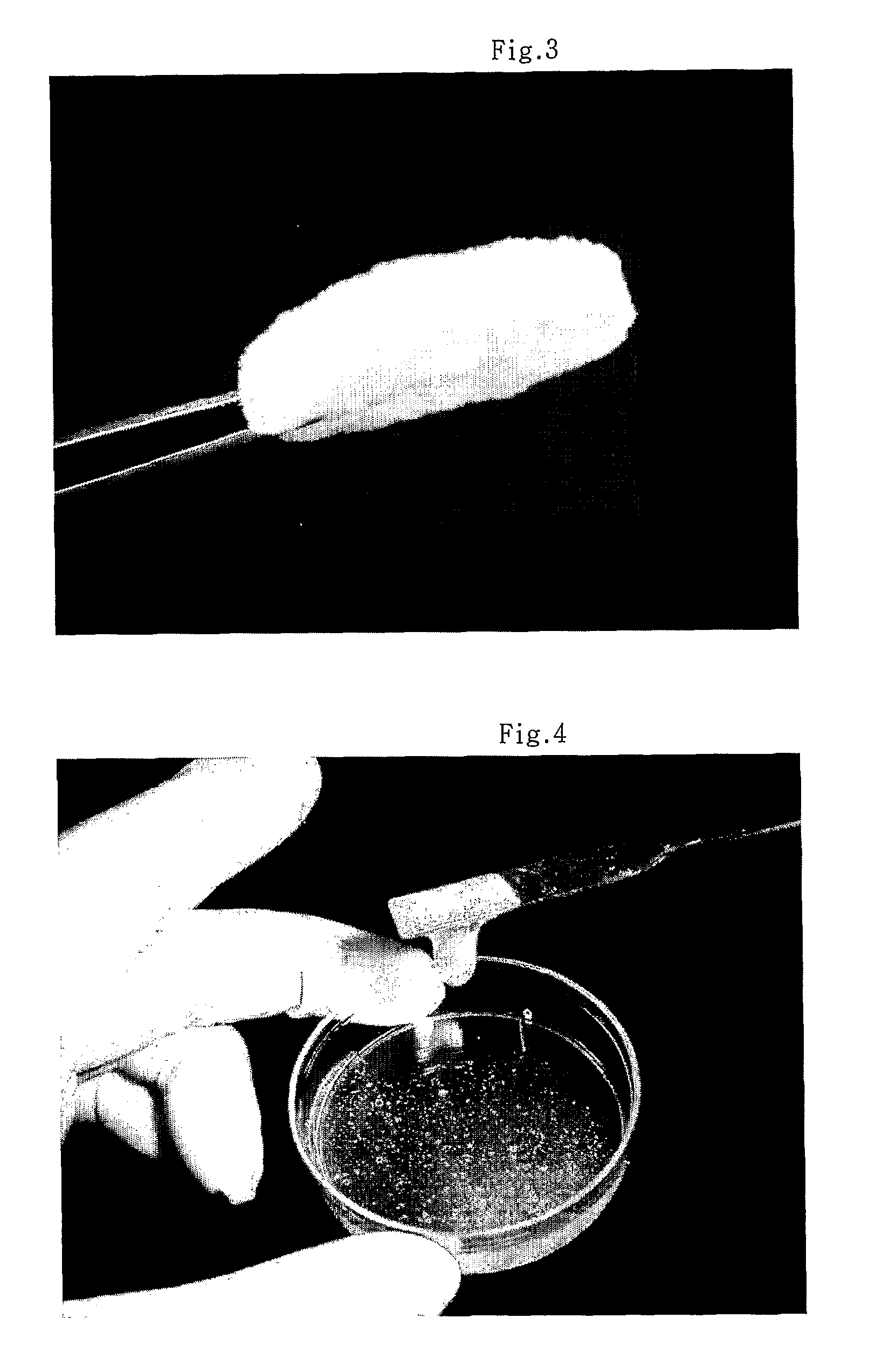Method of separating collagen from the various animal tissues for producing collagen solution and product using the same
a technology of collagen and animal tissues, which is applied in the field of collagen separation from various animal tissues, can solve the problems of inability to separate collagen from bone tissues, difficulty in pure collagen in a non-denaturated form, etc., and achieve the effects of improving quality and reliability of products, and enhancing customer satisfaction
- Summary
- Abstract
- Description
- Claims
- Application Information
AI Technical Summary
Benefits of technology
Problems solved by technology
Method used
Image
Examples
example 1
[0039]Porcine bone tissue was made into a powder having a particle size of 1 to 500 and was acid-treated with 0.5N HCl. Then, the acid-treated bone tissue was repeatedly treated with pepsin (2 to 5 times) for a long period of time (3 to 7 days) to separate type I collagen which was then subjected to salt treatment for fractionation and ethanol treatment, thereby obtaining collagen as 5 to 10% of the initial tissue weight. Specifically, this procedure will be described in more detail hereinafter:
[0040]1. Porcine-isolated bone tissue was thoroughly washed with distilled water, ethanol, acetone and the like.
[0041]2. The bone tissue was cut into a doughnut shape and stored at −20° C.
[0042]3. In order to separate collagen from the bone tissue, the bone tissue was made into a powder having a particle size of 1 to 500 μm.
[0043]4. The pulverized bone tissue was washed with ethanol and distilled water.
[0044]5. The thus-washed bone powder was treated overnight with 0.5N HCl while being shake...
example 2
[0057]Porcine cartilage tissue was made into a powder and was acid-treated with 0.5N HCl. Then, the acid-treated cartilage tissue was repeatedly treated with pepsin to separate type II collagen which was then subjected to salt treatment for fractionation and ethanol treatment, thereby obtaining collagen as 5 to 10% of the initial tissue weight. Specifically, this procedure will be described in more detail hereinafter:
[0058]1. Porcine-isolated cartilage tissue was thoroughly washed with distilled water, ethanol, acetone and the like.
[0059]2. In order to separate collagen from the cartilage tissue, the cartilage tissue was made into a powder having a particle size of 1 to 500 μm.
[0060]3. The pulverized cartilage tissue was washed with ethanol and distilled water.
[0061]4. The thus-washed cartilage tissue was treated overnight with a guanidine-HCl solution (4M guanidine-HCl, 0.05M Tris-HCl, pH 7.5),
[0062]5. The overnight-treated cartilage powder was washed once or twice with 0.1N HCl.
[0...
example 3
[0076]Porcine skin tissue was made into a section (500 μm to 5 μm thickness), and the tissue section was placed in a net having a lattice size of 200 to 500 μm and (was acid-treated with 0.1N HCl. Then, the acid-treated tissue) was repeatedly treated with pepsin to separate type I collagen which was then subjected to salt treatment for fractionation and ethanol treatment, thereby obtaining collagen as 10 to 15% of the initial tissue weight. Specifically, this procedure will be described in more detail hereinafter:
[0077]1. Porcine-isolated skin tissue was thoroughly washed with distilled water, ethanol and the like, and stored at −20° C.
[0078]2. In order to separate collagen from the skin tissue, the skin tissue was made into a section having a thickness of 500 μm to 5 mm.
[0079]3. The tissue section was placed in a net having a lattice size of 200 to 500 μm and washed with ethanol and distilled water.
[0080]4. The thus-washed tissue section was treated with pepsin (pepsin was treated ...
PUM
| Property | Measurement | Unit |
|---|---|---|
| particle size | aaaaa | aaaaa |
| time | aaaaa | aaaaa |
| temperature | aaaaa | aaaaa |
Abstract
Description
Claims
Application Information
 Login to View More
Login to View More - R&D
- Intellectual Property
- Life Sciences
- Materials
- Tech Scout
- Unparalleled Data Quality
- Higher Quality Content
- 60% Fewer Hallucinations
Browse by: Latest US Patents, China's latest patents, Technical Efficacy Thesaurus, Application Domain, Technology Topic, Popular Technical Reports.
© 2025 PatSnap. All rights reserved.Legal|Privacy policy|Modern Slavery Act Transparency Statement|Sitemap|About US| Contact US: help@patsnap.com



